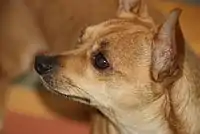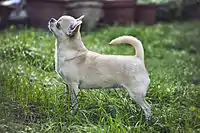Chihuahua (dog)
The Chihuahua (/tʃɪˈwɑːwə, -wɑː, -ˈwaʊ.ə/ (![]() listen);[1] Spanish: chihuahueño) is one of the smallest breeds of dog,[2] and is named after the Mexican state of Chihuahua.
listen);[1] Spanish: chihuahueño) is one of the smallest breeds of dog,[2] and is named after the Mexican state of Chihuahua.
| Chihuahua | |||||||||||||||||||||||||||||
|---|---|---|---|---|---|---|---|---|---|---|---|---|---|---|---|---|---|---|---|---|---|---|---|---|---|---|---|---|---|
 | |||||||||||||||||||||||||||||
| Origin | Mexico | ||||||||||||||||||||||||||||
| |||||||||||||||||||||||||||||
| |||||||||||||||||||||||||||||
| Dog (domestic dog) | |||||||||||||||||||||||||||||
History
Chihuahuas remained a rarity until the early 20th century and the American Kennel Club did not register a Chihuahua until 1904.[3]
Lineage
An analysis of DNA from the genome of domesticated dogs indicates that they entered North America from Siberia for 4,500 years and were then isolated for the next 9,000 years. After contact with Europeans, these lineages were replaced by Eurasian dogs and their local descendants. The pre-contact dogs exhibited a unique genetic signature that is now almost gone.[4] In 2020, the sequencing of ancient dog genomes indicates that in two Mexican breeds the Chihuahua retains 4% and the Xoloitzcuintli 3% pre-colonial ancestry.[5]
Appearance
Chihuahuas are the smallest breed recognized by some kennel clubs.[6]
There are two varieties of Chihuahua – the Smooth Coat (smooth-haired) and the Long Coat (long-haired). The Kennel Club considers the two to be distinct breeds; mating between the two are not eligible for KC registration.
Both the Smooth and Long Coats have their special attractions and are equally easy to keep clean and well-groomed.[7] The term smooth coat does not mean that the hair is necessarily smooth, as the hair can range from having a velvet touch to a whiskery feel. Longhaired Chihuahuas are actually smoother to the touch, having soft, fine-guard hairs and a downy undercoat, which gives them their fluffy appearance. Unlike many longhaired breeds, longhaired Chihuahuas require no trimming and minimal grooming. Contrary to popular belief, the longhaired breed also typically sheds less than its shorthaired counterparts. It may take up to three or more years before a full longhaired coat develops.
Current breed standards defined by registries specify an "apple-head" or "apple-dome" skull conformation.[8] Chihuahuas have large, round eyes and large, erect ears, set in a high, dramatically rounded skull.[6] The stop is well defined, forming a near 90 degree angle where the muzzle meets the skull.[9]
Breed standards for this dog do not generally specify a height; only a weight and a description of their overall proportions. Generally, the height ranges between 6 and 9 in (15 and 23 cm);[6] however, some dogs grow as tall as 30 to 38 cm (12 to 15 in). Both British and American breed standards state that a Chihuahua must not weigh more than 5.9 lb (2.7 kg) for conformation.[6]
However, the British standard also states that a weight of 4–6 lb (1.8–2.7 kg) is preferred. A clause stating, "if two dogs are equally good in type, the more diminutive one is preferred" was removed in 2009.[10] The Fédération Cynologique Internationale standard calls for dogs ideally between 1.5 and 3.0 kg (3.3 and 6.6 lbs), although smaller ones are acceptable in the show ring.[11]
Pet Chihuahuas(those bred or purchased as companions rather than show dogs) often range above these weights, even above 10 lbs, if they have large bone structures or are allowed to become overweight.[6] This does not mean that they are not purebred Chihuahuas; they just do not meet the requirements to enter a conformation show. Oversized Chihuahuas are seen in some of the best, and worst, bloodlines. Chihuahuas do not breed true for size, and puppies from the same litter can mature in drastically different sizes from one another. Also, larger breeding females are less likely to experience dystocia (obstructed labour). Many breeders try to breed Chihuahuas as small as possible, because those marketed as "teacup" or "tiny teacup" demand higher prices.[12]
Chihuahuas occur in virtually any color combination, from solid to marked or splashed,[13] allowing for colors from solid black to solid white, spotted, sabled, or a variety of other colors and patterns. Colors and patterns can combine and affect each other, resulting in a very high degree of variation. Common colors are fawn, red, cream, chocolate, brown, mixed, white, and black. No color or pattern is considered more valuable than another.
The Fédération Cynologique Internationale, which represents the major kennel clubs of 84 countries, disqualified the merle coat pattern, which appears mottled.[11] In May 2007, The Kennel Club decided not to register puppies with this coloration due to the health risks associated with the responsible gene, and in December of that year, formally amended its breed standard to disqualify merle dogs.[14]
Apple head vs. Deer head Chihuahuas


Dogs of any coat type may be identified as either "apple head" or "deer head" Chihuahuas. Apple heads have rounded heads, close-set eyes, and relatively short ears and legs. Deer heads have flat-topped heads, more widely set eyes, larger ears, and longer, more slender legs. Deer heads were the breed standard conformation in the mid-20th century, but current breed standards defined by registries such as the AKC specify the apple-head conformation.[8]
The Apple Head Chihuahua is known for having a round/apple-shaped head and a definite "stop" whereas a Deer Head Chihuahua "may" have a flatter head, thinner skull, but is unlikely to have a "stop" and will probably have a much longer nose. Their physical body shape is largely the same, except the Deer Head Chihuahua is known to have longer legs than other Chihuahuas. The Deer Head Chihuahua tends to be larger in weight, where an Apple Head is more likely to keep their weight under ten pounds.
Apple Head Chihuahuas are longer than they are tall and have shorter necks. Deer Head Chihuahuas have longer ears than Apple Heads and their head also has a slope-shaped form. Both Apple Head and Deer Head can have short hair or long hair. They also both come in various different colors such as brown, black, tan, or white. Chihuahuas can show traits from both Apple Head and Deer Head.
"Deer Head Chihuahuas tend to have better health than Apple Heads, due to their longer noses". There is no scientific evidence that Apple Heads have a higher risk of getting respiratory issues, due to having a smaller airway. Deer Headed Chihuahuas are not allowed in the AKC due to not meeting the standards that Apple Heads do. Deer Head Chihuahuas are not allowed because they have a longer jaw line and a slope that connects their muzzle and head, creating a 45 degree angle instead of a 90 degree angle like the Apple Head. Apple Heads are allowed in the AKC and meet the requirements due to having a smaller weight, having a rounder head, and also having a 90 degree angle formed by the muzzle to the forehead.[9]
Health
.jpg.webp)
This breed requires expert veterinary attention in areas such as birthing and dental care. Dental care is a must for these small dogs, whose jaw size makes for weaker teeth. Although daily brushing provides the best preventive measure, feeding a dental diet or using dental chews for dogs is an effective approach pet owners can take to help prevent and control accumulation of plaque and tartar to avoid consequences of severe periodontal disease.[15]
Chihuahuas, and other toy breeds, can be affected by hydrocephalus.[16]
See also
| Wikimedia Commons has media related to: |
References
- Wells, John (April 3, 2008). Longman Pronunciation Dictionary (3rd ed.). Pearson Longman. ISBN 978-1-4058-8118-0.
- "The 25 Smallest Dog Breeds". American Kennel Club. Retrieved January 26, 2021.
- Coile, C. (2013). Chihuahuas: Everything about purchase, care, nutrition, behavior, and training. Hauppauge, NY: Barron’s Educational Series, p. 7: "Only in 1904 did the American Kennel Club (AKC) register its first Chihuahua; a total of five were registered that year.”
- Ní Leathlobhair, Máire; Perri, Angela R.; Irving-Pease, Evan K.; Witt, Kelsey E.; Linderholm, Anna; Haile, James; Lebrasseur, Ophelie; Ameen, Carly; Blick, Jeffrey; Boyko, Adam R.; Brace, Selina; Cortes, Yahaira Nunes; Crockford, Susan J.; Devault, Alison; Dimopoulos, Evangelos A.; Eldridge, Morley; Enk, Jacob; Gopalakrishnan, Shyam; Gori, Kevin; Grimes, Vaughan; Guiry, Eric; Hansen, Anders J.; Hulme-Beaman, Ardern; Johnson, John; Kitchen, Andrew; Kasparov, Aleksei K.; Kwon, Young-Mi; Nikolskiy, Pavel A.; Lope, Carlos Peraza; Manin, Aurélie; Martin, Terrance; Meyer, Michael; Myers, Kelsey Noack; Omura, Mark; Rouillard, Jean-Marie; Pavlova, Elena Y.; Sciulli, Paul; Sinding, Mikkel-Holger S.; Strakova, Andrea; Ivanova, Varvara V.; Widga, Christopher; Willerslev, Eske; Pitulko, Vladimir V.; Barnes, Ian; Gilbert, M. Thomas P.; Dobney, Keith M.; Malhi, Ripan S.; Murchison, Elizabeth P.; Larson, Greger; Frantz, Laurent A. F. (July 6, 2018). "The evolutionary history of dogs in the Americas". Science. 361 (6397): 81–85. Bibcode:2018Sci...361...81N. doi:10.1126/science.aao4776. PMID 29976825. S2CID 206663458.
- Bergström, Anders; Frantz, Laurent; Schmidt, Ryan; Ersmark, Erik; Lebrasseur, Ophelie; Girdland-Flink, Linus; Lin, Audrey T.; Storå, Jan; Sjögren, Karl-Göran; Anthony, David; Antipina, Ekaterina; Amiri, Sarieh; Bar-Oz, Guy; Bazaliiskii, Vladimir I.; Bulatović, Jelena; Brown, Dorcas; Carmagnini, Alberto; Davy, Tom; Fedorov, Sergey; Fiore, Ivana; Fulton, Deirdre; Germonpré, Mietje; Haile, James; Irving-Pease, Evan K.; Jamieson, Alexandra; Janssens, Luc; Kirillova, Irina; Horwitz, Liora Kolska; Kuzmanovic-Cvetković, Julka; Kuzmin, Yaroslav; Losey, Robert J.; Dizdar, Daria Ložnjak; Mashkour, Marjan; Novak, Mario; Onar, Vedat; Orton, David; Pasaric, Maja; Radivojevic, Miljana; Rajkovic, Dragana; Roberts, Benjamin; Ryan, Hannah; Sablin, Mikhail (2020). "Origins and genetic legacy of prehistoric dogs". Science. 370 (6516): 557–564. doi:10.1126/science.aba9572. S2CID 225956269.
- Charlotte Wilcox (April 1, 1999). "Quick Facts". The Chihuahua. Capstone. pp. 4–5. ISBN 978-0-7368-0158-4. Retrieved March 1, 2013.
- "The Kennel Club". Retrieved October 5, 2015.
- Walker, Joan Hustace (2006). The Everything Chihuahua Book: A Complete Guide to Raising, Training, And Caring for Your Chihuahua. Adams Media. pp. 16–18. ISBN 9781440523687. Retrieved June 15, 2019.
- "Official Standard of the Chihuahua" (PDF). Retrieved November 12, 2019.
- "The Kennel Club". thekennelclub.org.uk.
- "Chihuahua standard" (PDF). Fédération Cynologique Internationale. July 28, 2009. Retrieved October 25, 2011.
- Segovia, Stacey Smith (March 21, 2004). "Runt of the litter". The Leaf Chronicle. ProQuest 441596979.
- American Kennel Club Chihuahua page, retrieved on July 29, 2007.
- "Kennel Club breed standard". Thekennelclub.org.uk. May 15, 2006. Archived from the original on January 3, 2009. Retrieved August 14, 2009.
- Logan, Ellen I. (2006), "Dietary Influences on Periodontal Health in Dogs and Cats", Veterinary Clinics of North America: Small Animal Practice, Elsivier Saunders, 36 (6): 1385–1401, doi:10.1016/j.cvsm.2006.09.002, PMID 17085242
- "Hydrocephalus". Genetic Welfare Problems of Companion Animals. ufaw.org.uk: Universities Federation for Animal Welfare. Archived from the original on April 10, 2013. Retrieved February 10, 2015.